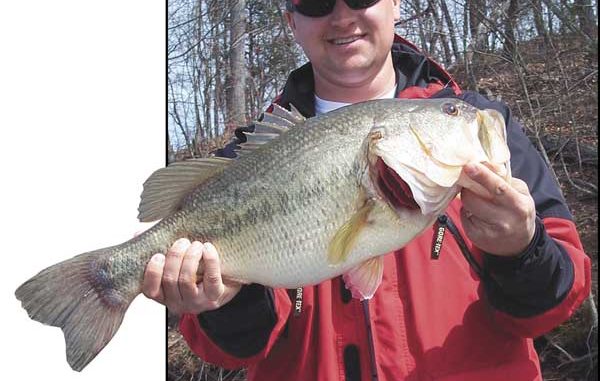
Across most of North Carolina, May brings the post-spawn time for bass.
A few late spawners still will be on beds at the state’s northern- and western-most lakes, but for the most part, anglers will be dealing with post-spawners.That means they can expect the traditional post-spawn topwater bite, along with largemouth bass chasing schools of shad spawning at steep banks.
Another great-but-often-overlooked pattern develops with jigs. Bass are hungry after a long spawning season and are looking for a big meal. Jigs have the bulk that appeals to these famished fish.
Several major tournaments have been won in recent years by anglers using football-head jigs during May. They fish these jigs in places that would be traditional areas for a Carolina rig or crankbait.
Other productive tournament techniques include swimming jigs through shallow cover and standing timber, flipping heavy cover and “stroking” (pulling a jig high off the bottom with a quick lift of the rod tip and letting it fall back).
First, the football jig is limited to lakes or areas of lakes without grass, as the head is prone to becoming fouled in vegetation. However its wide head comes through rocks well and tends to have a rocking motion that lifts the trailer in a defensive “crawfish” posture. And that action is appealing to bass at rocky points as they hunt crawfish, a favorite food.
Football jigs are designed for casting and have light wire hooks. Using 10- to 15-pound test fluorocarbon line also helps anglers feel the bottom and get more bites.
Most football jigs are heavy, from ½ to 1 ounce and have been designed to be fished at the bottom and in a fast manner. Fishing quickly until making contact with some sort of cover where the angler can shake the lure in place is often the best way to fish a football-head jig.
Normally, these jigs work best in slightly stained to clear water.
Another great way to fish a jig during May is to swim them through shallow cover or through areas that may have suspended fish.
White, natural shad hues and bluegill colors are ideal because anglers aren’t trying to imitate crawfish but rather the baitfish that are suspended in the water column.
Experiment with retrieves. Sometimes a slow pumping action works great; other times a frantic retrieve draws reaction strikes from shallow bass.
Other areas to consider swimming a jig are underneath docks, at standing timber and rip rap banks. Bass often suspend during May, and anglers often present lures beneath them.
If you’re getting a lot of bites as your jig initially falls, you may need to use a swimming retrieve.
An awesome trailer for swimming jigs is the original Culprit Frog. Its small size and two thin kicking legs look really natural in the water. It also has a flat body that helps keep a heavier jig up in the water column.
Other trailers to consider are traditional pork shapes, twin-tail and single-tail grubs.
As always, anglers can’t go wrong flipping a jig into shallow heavy cover. Bass live in this type of cover year round and sit and wait for a chance to attack a bait.
A properly-presented jig at the heart of shallow cover is a great way to catch big bass during May and the rest of the year.
I normally use 20-pound fluorocarbon and a Daiwa LT or Cielo 7 1/2-foot-long flippin’ stick in this situation. Jigs with short shanks and strong wire hooks get the nod.
I’ve found a 7.1:1 reel (retrieve ratio) is a big advantage for taking up line with fast- swimming fish and helps to not waste time reeling between casts. I prefer a Daiwa Zillion, but several manufacturers make fast-retrieve reels.
The last-but-not-least jig technique to consider is “stroking.”
When an angler is stroking, he’s trying to accomplish two goals during the retrieve — getting as many vertical lure falls as he can after a cast and generating reaction strikes by using a quick-snatching retrieve.
To stroke properly, it almost looks like you’re setting the hook every couple of seconds. It’s important to leave a little slack in the line at the top of the snatch so the jig will fall vertically when you let it drop.
I use jigs from 3/8- to ¾-ounce with this technique, and the jig color doesn’t seem to matter.
So give jigs a try during May and think about your retrieve options and areas to test them.
Maybe you can devise a new way to jig fish that bass haven’t seen. Usually one or more jig techniques work during May. They also often win tournaments with better-than-average-size lunker largemouths.
Even if you don’t fish as a pro, a whopping bass caught with a jig should please any angler.
Dustin Wilks is a 31-year-old professional bass angler and Raleigh native now living in Rocky Mount. He has qualified for the Bassmaster Classic four times and operates Fish Like a Pro Fishing Lessons (252-883-6749, www.fishlikeapro.com ). His sponsors include Assassinator Spinnerbaits, Chatterbuzz, Skeeter Boats, Yamaha, Daiwa, Keelshield and Culprit.



Be the first to comment